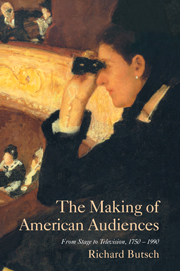Book contents
- Frontmatter
- Contents
- Acknowledgments
- Introduction: Participative Public, Passive Private?
- 1 Colonial Theater, Privileged Audiences
- 2 Drama in Early Republic Audiences
- 3 The B'Hoys in Jacksonian Theaters
- 4 Knowledge and the Decline of Audience Sovereignty
- 5 Matinee Ladies: Re-gendering Theater Audiences
- 6 Blackface, Whiteface
- 7 Variety, Liquor, and Lust
- 8 Vaudeville, Incorporated
- 9 “Legitimate” and “Illegitimate” Theater around the Turn of the Century
- 10 The Celluloid Stage: Nickelodeon Audiences
- 11 Storefronts to Theaters: Seeking the Middle Class
- 12 Voices from the Ether: Early Radio Listening
- 13 Radio Cabinets and Network Chains
- 14 Rural Radio: “We Are Seldom Lonely Anymore”
- 15 Fears and Dreams: Public Discourses about Radio
- 16 The Electronic Cyclops: Fifties Television
- 17 A TV in Every Home: Television “Effects”
- 18 Home Video: Viewer Autonomy?
- 19 Conclusion: From Effects to Resistance and Beyond
- Appendix: Availability, Affordability, Admission Price
- Notes
- Selected Bibliography
- Index
- Plate section
2 - Drama in Early Republic Audiences
Published online by Cambridge University Press: 05 June 2012
- Frontmatter
- Contents
- Acknowledgments
- Introduction: Participative Public, Passive Private?
- 1 Colonial Theater, Privileged Audiences
- 2 Drama in Early Republic Audiences
- 3 The B'Hoys in Jacksonian Theaters
- 4 Knowledge and the Decline of Audience Sovereignty
- 5 Matinee Ladies: Re-gendering Theater Audiences
- 6 Blackface, Whiteface
- 7 Variety, Liquor, and Lust
- 8 Vaudeville, Incorporated
- 9 “Legitimate” and “Illegitimate” Theater around the Turn of the Century
- 10 The Celluloid Stage: Nickelodeon Audiences
- 11 Storefronts to Theaters: Seeking the Middle Class
- 12 Voices from the Ether: Early Radio Listening
- 13 Radio Cabinets and Network Chains
- 14 Rural Radio: “We Are Seldom Lonely Anymore”
- 15 Fears and Dreams: Public Discourses about Radio
- 16 The Electronic Cyclops: Fifties Television
- 17 A TV in Every Home: Television “Effects”
- 18 Home Video: Viewer Autonomy?
- 19 Conclusion: From Effects to Resistance and Beyond
- Appendix: Availability, Affordability, Admission Price
- Notes
- Selected Bibliography
- Index
- Plate section
Summary
Colonial theater was barely on its feet when the Revolution halted its growth. There had been a flurry of theater construction after 1767, perhaps stimulated by the growing population. But the Puritan characterization of theater as an extravagance gained wider acceptance during the hardships of the Revolution. The First Continental Congress in October 1774 passed a resolution to “discourage every species of extravagance and dissipation, especially all horse-racing, and all kinds of gaming, cock-fighting, exhibition of shews, plays, and other expensive diversions and entertainments.” In October 1778, the Congress passed another resolution that states should suppress theatrical entertainments as causing “idleness, dissipation, and a general depravity of principles and manners”; and that officeholders who encouraged plays should be dismissed. The language in part reflected the displacement of the culture of deference in which the leisured class was seen as creating work for commoners through their consumption, by language that condemned leisure as idleness and instead called for industriousness. Remarkably, theater was not condemned as British – perhaps too many members of the Congress were patrons of theater to label it traitorous. Indeed some did not abide by the resolutions. Baltimore built a theater after the resolution of 1778 was passed, and there is some indication that a troupe played there and at Annapolis during the war. Plays were performed in Pennsylvania as well. In general, however, theater during the war was reduced to performances by British officers in cities occupied by their troops.
- Type
- Chapter
- Information
- The Making of American AudiencesFrom Stage to Television, 1750–1990, pp. 32 - 43Publisher: Cambridge University PressPrint publication year: 2000

